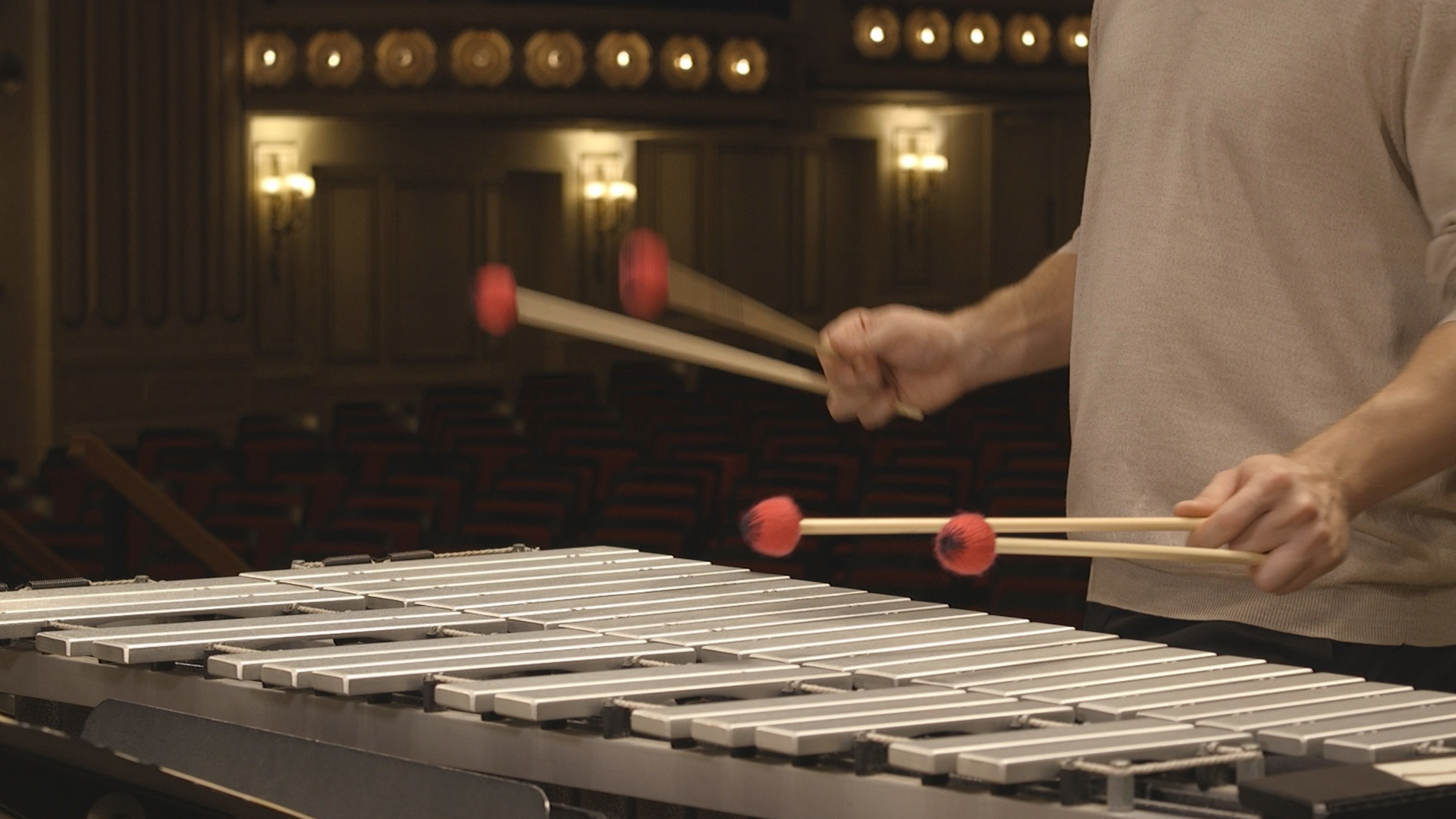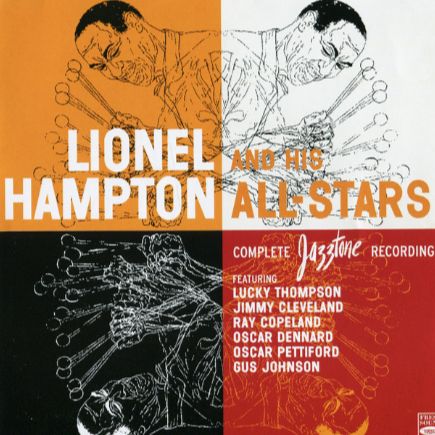Lionel Hampton, pionnier du vibraphone dans le jazz
Lionel Hampton, vibraphoniste, pianiste et batteur américain surnommé ‘The Lion’, demeure l’une des figures majeures de l’histoire du jazz. Premier musicien à imposer le vibraphone comme instrument soliste, il a marqué durablement l’évolution du swing et ouvert la voie à des générations d’instrumentistes.
Sa jeunesse fut instable: après avoir suivi sa famille de ville en ville, il s’installe à Chicago en 1916. Il débute à la batterie et rejoint bientôt le Chicago Defender Newsboy’s Band, dirigé par Jimmy Bertrand. Dans ce cadre, il approfondit son apprentissage musical tout en se produisant dans des clubs modestes et auprès de formations locales.
Sa carrière prend un tournant décisif lorsqu’il s’établit en Californie en 1928. À Los Angeles, il intègre l’orchestre de Les Hite, qui assurait alors les premières parties de Louis Armstrong. C’est Armstrong lui-même qui, impressionné par son talent, l’encourage à se produire au vibraphone. Le succès rencontré est immédiat, au point qu’Hampton délaisse définitivement la batterie pour se consacrer à cet instrument encore méconnu.
La consécration arrive en 1936, lorsque Benny Goodman, alors surnommé le ‘Roi du swing’, assiste à une de ses prestations à Los Angeles. Séduit, il l’invite à rejoindre son trio, puis son quartet, aux côtés de Teddy Wilson et Gene Krupa. Cette collaboration, qui dura quatre ans, reste l’un des moments fondateurs de l’histoire du swing, marquée par des enregistrements emblématiques tels que Moonglow ou Dinah.
En 1940, Lionel Hampton fonde son propre big band, une formation qui s’impose rapidement comme un véritable vivier de talents. De grands solistes y feront leurs armes: Clifford Brown, Charles Mingus, Quincy Jones, Art Farmer, Dinah Washington, Illinois Jacquet ou encore Dexter Gordon. L’orchestre, réputé pour son énergie et sa cohésion, s’est maintenu actif pendant plusieurs décennies, établissant un record de longévité dans l’histoire du jazz.
Hampton s’est illustré par son jeu puissant, son sens du swing irrésistible et une énergie communicative qui électrisait le public. Des albums marquants comme Flying Home ou Hamp’s Boogie Woogie témoignent de sa capacité à conjuguer virtuosité rythmique, lyrisme et sens du spectacle. Reconnu aussi bien comme musicien que comme chef d’orchestre, Lionel Hampton a contribué à populariser le jazz auprès d’un large public, tout en ouvrant la voie à l’intégration du vibraphone dans le langage du jazz moderne.
Lionel Hampton, pionero del vibráfono en el jazz
Lionel Hampton, vibrafonista, pianista y baterista estadounidense apodado ‘The Lion’, permanece como una de las figuras más influyentes en la historia del jazz. Primer músico en imponer el vibráfono como instrumento solista, marcó de manera decisiva la evolución del swing y abrió el camino a generaciones de instrumentistas.
Su juventud fue inestable: tras seguir a su familia de ciudad en ciudad, se instaló en Chicago en 1916. Comenzó con la batería y pronto se unió a la Chicago Defender Newsboy’s Band, dirigida por Jimmy Bertrand. Allí profundizó su formación musical mientras actuaba en clubes modestos y con agrupaciones locales.
Su carrera dio un giro decisivo en 1928, cuando se estableció en California. En Los Ángeles se incorporó a la orquesta de Les Hite, que entonces acompañaba a Louis Armstrong en sus presentaciones. Fue el propio Armstrong quien, impresionado por su talento, lo animó a tocar el vibráfono. El éxito fue inmediato, y Hampton abandonó definitivamente la batería para dedicarse a este instrumento todavía poco conocido.
La consagración llegó en 1936, cuando Benny Goodman, apodado el ‘Rey del swing’, asistió a una de sus presentaciones en Los Ángeles. Fascinado, lo invitó a unirse a su trío y luego a su cuarteto, junto a Teddy Wilson y Gene Krupa. Esta colaboración, que duró cuatro años, permanece como uno de los hitos fundacionales de la historia del swing, marcada por grabaciones emblemáticas como Moonglow o Dinah.
En 1940, Hampton formó su propia big band, que pronto se convirtió en un auténtico semillero de talentos. Por sus filas pasaron grandes solistas como Clifford Brown, Charles Mingus, Quincy Jones, Art Farmer, Dinah Washington, Illinois Jacquet o Dexter Gordon. La orquesta, célebre por su energía y cohesión, se mantuvo activa durante varias décadas, alcanzando un récord de longevidad en el jazz.
Hampton se distinguió por un estilo poderoso, un sentido del swing irresistible y una energía comunicativa capaz de electrizar al público. Álbumes emblemáticos como Flying Home o Hamp’s Boogie Woogie evidencian su habilidad para unir virtuosismo rítmico, lirismo y espectáculo. Reconocido como músico y director, Lionel Hampton contribuyó a popularizar el jazz ante un público amplio y abrió definitivamente las puertas del vibráfono al lenguaje del jazz moderno.
Lionel Hampton, pioniere del vibrafono nel jazz
Lionel Hampton, vibrafonista, pianista e batterista statunitense soprannominato ‘The Lion’, rimane una delle figure più influenti della storia del jazz. Primo musicista a imporre il vibrafono come strumento solista, segnò in modo duraturo l’evoluzione dello swing e aprì la strada a generazioni di strumentisti.
La sua giovinezza fu instabile: dopo aver seguito la famiglia di città in città, si stabilì a Chicago nel 1916. Iniziò con la batteria ed entrò presto nella Chicago Defender Newsboy’s Band, diretta da Jimmy Bertrand. In quel contesto affinò la sua formazione musicale, esibendosi in club modesti e con piccoli complessi locali.
La sua carriera prese una svolta decisiva nel 1928, quando si trasferì in California. A Los Angeles entrò nell’orchestra di Les Hite, che allora accompagnava Louis Armstrong nelle sue apparizioni. Fu lo stesso Armstrong, colpito dal suo talento, a incoraggiarlo a suonare il vibrafono. Il successo fu immediato, tanto che Hampton abbandonò definitivamente la batteria per dedicarsi a questo strumento ancora poco conosciuto.
La consacrazione arrivò nel 1936, quando Benny Goodman, soprannominato il ‘Re dello swing’, assistette a una sua esibizione a Los Angeles. Affascinato, lo invitò a unirsi al suo trio e successivamente al suo quartetto, insieme a Teddy Wilson e Gene Krupa. Questa collaborazione, durata quattro anni, resta una delle pietre miliari della storia dello swing, caratterizzata da incisioni emblematiche come Moonglow o Dinah.
Nel 1940, Hampton fondò la sua big band, che si affermò rapidamente come un autentico vivaio di talenti. Vi militarono grandi solisti come Clifford Brown, Charles Mingus, Quincy Jones, Art Farmer, Dinah Washington, Illinois Jacquet e Dexter Gordon. L’orchestra, celebre per energia e coesione, rimase attiva per diverse decadi, stabilendo un primato di longevità nella storia del jazz.
Hampton si distinse per il suo stile potente, il senso irresistibile dello swing e un’energia comunicativa capace di trascinare il pubblico. Album memorabili come Flying Home o Hamp’s Boogie Woogie testimoniano la sua abilità nel coniugare virtuosismo ritmico, lirismo e spettacolo. Riconosciuto sia come musicista che come direttore, Lionel Hampton contribuì a diffondere il jazz presso un vasto pubblico, aprendo definitivamente le porte del vibrafono al linguaggio del jazz moderno.
Lionel Hampton, pioneer of the vibraphone in jazz
Lionel Hampton, American vibraphonist, pianist, and drummer nicknamed ‘The Lion’, stands as one of the most influential figures in the history of jazz. The first musician to establish the vibraphone as a solo instrument, he left a lasting mark on the development of swing and paved the way for generations of instrumentalists.
His early years were unsettled: after moving with his family from city to city, he settled in Chicago in 1916. He began on drums and soon joined the Chicago Defender Newsboy’s Band, led by Jimmy Bertrand. There he deepened his musical training while performing in modest clubs and with local groups.
His career took a decisive turn in 1928 when he moved to California. In Los Angeles, he joined Les Hite’s orchestra, which was then opening for Louis Armstrong. It was Armstrong himself, impressed by Hampton’s talent, who encouraged him to perform on the vibraphone. The success was immediate, and Hampton gave up the drums to dedicate himself entirely to this still little-known instrument.
His breakthrough came in 1936, when Benny Goodman, known as the ‘King of Swing’, attended one of his performances in Los Angeles. Captivated, Goodman invited him to join his trio and later his quartet, alongside Teddy Wilson and Gene Krupa. This collaboration, which lasted four years, remains one of the founding moments of swing history, marked by emblematic recordings such as Moonglow and Dinah.
In 1940, Hampton founded his own big band, which quickly became a true breeding ground for talent. Outstanding musicians such as Clifford Brown, Charles Mingus, Quincy Jones, Art Farmer, Dinah Washington, Illinois Jacquet, and Dexter Gordon all passed through its ranks. Renowned for its energy and cohesion, the orchestra remained active for decades, setting a record for longevity in jazz history.
Hampton distinguished himself through a powerful style, an irresistible sense of swing, and a communicative energy that electrified audiences. Landmark recordings such as Flying Home and Hamp’s Boogie Woogie reveal his ability to blend rhythmic virtuosity, lyricism, and showmanship. Celebrated both as a musician and as a bandleader, Lionel Hampton helped bring jazz to a wide audience while firmly establishing the vibraphone in the language of modern jazz.

Autres articles – Otros artículos – Altri articoli
Louis ARMSTRONG (04.08.1901–06.07.1971)
Clifford BROWN (30.10.1930–26.06.1956)
Art FARMER (21.08.1928–04.10.1999)
Benny GOODMAN (30.05.1909–13.06.1986)
Dexter GORDON (27.02.1923–25.04.1990)
Illinois JACQUET (31.10.1922–22.07.2004)
Quincy JONES (14.03.1933–03.11.2024)
Gene KRUPA (15.01.1909–16.10.1973)
Charles MINGUS (22.04.1922–05.01.1979)

